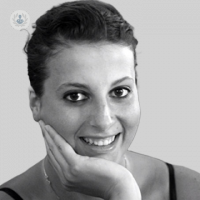Spinal cord injury: An expert guide to diagnosis, treatment and rehabilitation
Escrito por:A spinal cord injury is defined as damage to the spinal cord due to trauma, disease or degeneration that causes temporary or permanent changes in its function. In many cases, a spinal cord injury is physically, mentally and emotionally distressing, affecting nearly all aspects of life.
In this article, Dr Piera Santullo, highly-renowned consultant in rehabilitation medicine, provides a comprehensive insight into a spinal cord injury. The Birmingham-based specialist discusses diagnosis, treatment, rehabilitation, and overall recovery.

What are the signs and symptoms of a spinal cord injury?
The signs and symptoms of a spinal cord injury can vary, depending on the location and severity of the injury.
Common signs and symptoms include:
- Loss of movement: If the spinal cord is completely severed, there will be loss of movement below the level of the injury.
- Loss of sensation: A patient with a spinal cord injury may experience loss of sensation, including the ability to feel hot or cold, to feel pressure, and to feel pain below the level of the injury.
- Loss of bladder or bowel control: A spinal cord injury can affect the ability to control bladder and bowel movements.
- Difficulty breathing: If the injury is high on the spinal cord, it can affect the muscles involved in breathing.
- Spasms or exaggerated reflexes: A patient with a spinal cord injury may experience muscle spasms or exaggerated reflexes.
- Changes in sexual function: A spinal cord injury can affect sexual function, including the ability to achieve an erection or an orgasm.
- Pain or intense stinging: Some patients experience intense stinging or pain in the affected area.
It’s important to seek medical attention immediately if a spinal cord injury is suspected. Early treatment can help prevent further damage and improve outcomes.
How are spinal cord injuries diagnosed?
The diagnosis of a spinal cord injury typically involves a combination of medical history, physical examination, and a range of diagnostic tests.
Common methods of diagnosis include:
- Medical history: A doctor will take a detailed medical history, including the circumstances and timing of the injury, as well as any symptoms a patient is experiencing.
- Physical examination: A doctor will perform a physical examination to assess neurological function, including strength, sensation, and reflexes.
- Imaging tests: Imaging tests such as X-rays, CT scans, or MRI scans may be used to visualise the spinal cord and surrounding structures, and to identify any fractures, dislocations, or other abnormalities.
- Electromyography (EMG): An EMG may be used to assess nerve and muscle function, and to identify any damage to the nerves that control the muscles.
- Somatosensory evoked potentials (SSEPs): SSEPs tests are used to measure the electrical activity of the spinal cord in response to sensory stimulation. This can help identify the location and the extent of the spinal cord damage.
- Diagnostic injections: In some cases, diagnostic injections may be used to help identify the source of pain or other symptoms.
The specific diagnostic tests used will depend on each patient’s specific symptoms and the suspected location and severity of the spinal cord injury.
How are spinal cord injuries treated?
The treatment of a spinal cord injury depends on the severity of the injury and the specific symptoms. In general, the primary goals of treatment are to: stabilise the spine to prevent further damage; control inflammation and other secondary effects of the injury; and facilitate recovery of function.
In cases of severe spinal cord injury, immediate medical attention is required to prevent further damage and to stabilise the spine. This may involve the use of a neck or back brace, traction, or surgery to realign and stabilise the spine.
After the initial treatment, rehabilitation is an important part of the recovery process. This may involve physical therapy, occupational therapy, or other forms of therapy to help patients regain strength, mobility, and function. Other treatments may include medications to control pain and inflammation, and assistive devices such as wheelchairs or braces to help patients move around.
In some cases, treatments such as stem cell therapy or electrical stimulation may be used to promote healing or to restore function. However, these treatments are still in the early stages of development and their effectiveness is not yet fully known.
Overall, the treatment of a spinal cord injury requires a multidisciplinary approach involving a team of healthcare professionals, including neurosurgeons, physical therapists, occupational therapists, and more specialists to provide the best possible care.
How long does it take for the injury to heal?
The duration of spinal cord injury rehabilitation can vary, depending on the severity of the injury and each patient’s specific needs and goals. Generally, rehabilitation for a spinal cord injury can take from several months to years.
In the acute phase, the focus is on: stabilising the injury; preventing further damage; and addressing any immediate medical issues. This phase can last from several weeks to months, depending on the extent of the injury.
Following the acute phase, rehabilitation typically begins. The goal of rehabilitation is to help patients regain as much function as possible and, if needed, to learn how to live with any permanent disabilities.
It's important to know that spinal cord injury rehabilitation is an ongoing process that may continue for many years. This is because patients who have a spinal cord injury may continue to experience changes in their condition and require ongoing support and care.
Rehabilitation for a spinal cord injury
Rehabilitation plays a crucial role in the recovery of patients who have a spinal cord injury. It’s typically a long-term process that may involve a range of different therapies and interventions to improve a patient’s quality of life.
Some of the key aspects of rehabilitation for a spinal cord injury include:
- Physical therapy: Physical therapy focuses on improving mobility, strength, balance, and coordination. This may involve exercises to help patients regain movement in their arms and legs, as well as training in the use of assistive devices such as wheelchairs and braces.
- Occupational therapy: Occupational therapy focuses on helping patients develop the skills they need to perform daily activities, such as getting dressed and cooking meals. This may also include training in the use of adaptive devices to help patients perform these activities more independently.
- Speech therapy: Speech therapy may be required for patients who have difficulty speaking or swallowing due to their injury. This may involve exercises to strengthen the muscles used in speech and swallowing, as well as training in techniques that improve speech and communication.
- Psychological counselling: A spinal cord injury can be a traumatic and life-changing event, and psychological counselling can help patients and their families adjust to the physical and emotional challenges of the injury. This may involve counselling to help patients manage depression, anxiety, and other emotional issues.
- Vocational rehabilitation: Vocational rehabilitation focuses on helping patients return to work or to find new employment that is suitable for their level of function and disability.
Overall, rehabilitation for a spinal cord injury is a complex and ongoing process that requires a team approach. The rehabilitation team may include physicians, nurses, physical therapists, occupational therapists, speech therapists, psychologists, and other specialists, all working together to help patients achieve their goals and maximise their independence.
Dr Piera Santullo is a leading consultant in rehabilitation medicine with over a decade of experience who specialises in spinal cord injury rehabilitation, among other areas of expertise.
If you or a loved one are in need of treatment and rehabilitation for a spinal cord injury, don’t hesitate to book an appointment with Dr Santullo via her Top Doctors profile today.



